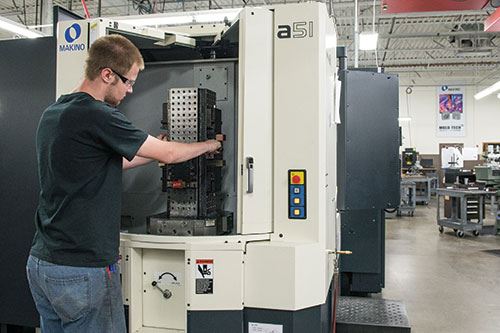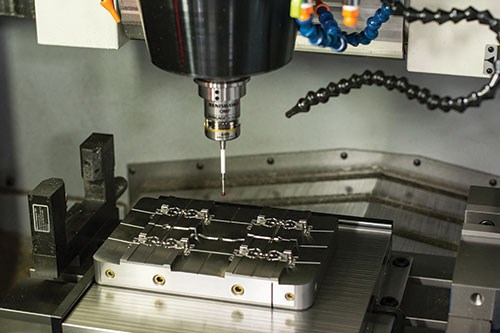The Knowledge-Driven Operation
From management to shop floor, putting control of processes and workflow in the right hands accounts for much of this growing mold manufacturer’s success.
Mold-Tech’s facility in Albertville, Minnesota, will soon look very different. To accommodate recent growth, this manufacturer of tight-tolerance, high-cavitation injection molds has embarked on an expansion that, when complete, will bring the company to occupy 24,000 square feet—double its current size.
Judging from past experience, the shop is well-prepared to handle additional capacity. Challenges presented by previous growth periods led company President Jon Lee and the rest of the leadership to reconsider how decisions are made about processing work and dealing with customers. From management to shop floor, letting mold manufacturing knowledge and skill drive the operation has improved efficiency and quality alike. It’s also made the company more attractive for prospective employees. Over the years, these gains have proven critical to managing the complexity that comes with additional work and new capabilities, Lee says, and the current growth period should be no exception.
A Single Point of Contact
The structural shifts began about seven years ago, when Mold-Tech moved to provide customers with a single point of contact for any given project. Rather than an outside sales force, the shop has four dedicated project managers who split all accounts among them. Every new program is assigned to one of these four managers, who takes complete ownership, from RFQ to shipping qualified tooling. This strategy helps build better relationships because the same project managers work repeatedly with the same customers, Lee says. It also eliminates any confusion as to whom the customer should contact with any issues.
Just as importantly, customers can rest assured that any questions will be answered not only promptly, but accurately, too, no matter how technical. Sales skills aren’t enough (or even the top priority) to become a Mold-Tech project manager, Lee explains. Indeed, the project managers had to learn the intricacies of quoting and customer service over time, on the job, because they’d spent most of their careers building molds. That experience makes them more than qualified to not only answer questions, but to act as a single point of contact for the rest of the shop, too.
Although Lee says they rarely “get their hands dirty,” the project managers are typically heavily involved during the design phase, and they carry the lion’s share of the responsibility for satisfying all job requirements and meeting deadlines. Having a single person in control of a program reduces the chance for miscommunication, confusion and power struggles as molds progress through the shop, he says. It also helps meet budgets, because the person who quoted the job is also responsible for keeping it on track. In fact, these internal benefits were a big part of the reason why the shop transitioned to this structure in the first place. “As more and more jobs came in, it became too cumbersome to operate the way we were,” Lee says. “Divvying out jobs and having a single point of contact for each is easier for us and for customers alike.”
Tearing Down Walls
Although the project managers have final say on any aspect of the build, shopfloor employees shoulder more responsibility compared to previous years. “We’ve come full circle,” Lee says about the shop’s approach to programming CAM tool paths. “About 15 years ago, the big push was to take CAM out of the shop and put it in the hands of dedicated programmers in engineering. Like many others, we went down that path. But over time, we found it had created some problems.”
That’s because taking programming off the floor essentially hamstrung the ability of some of the shop’s most knowledgeable personnel to influence the manufacturing process, he explains. That’s not to say that Mold-Tech’s dedicated CAM programmers were incompetent—quite the contrary, he says. Yet, even the most skilled among them couldn’t hope to master the intricacies of each and every piece of CNC equipment in the shop. Meanwhile, those responsible for working intimately with the same technology day-in and day-out had essentially been relegated to the roles of overseers. By the time a finished part program could be thrown over the proverbial wall, it was too late to leverage these employees’ extensive knowledge of their own particular portions of the build.
Mold-Tech decided to tear down that wall about the same time it implemented project managers, and the shop hasn’t looked back since. Today, the person who runs a machine is also responsible for programming it. Although adopting this approach required new workstation computers and CAM software training, those investments have since been recouped many times over, Lee says. Manufacturing is more efficient because chosen toolpath strategies are more likely to take full advantage of the capabilities of any given piece of equipment. Scrap has been reduced as well, as has the risk of interdepartmental finger-pointing in the event of a mistake.
The CNC specialists on the floor are also far more confident in programs they generate themselves—confident enough to feel that they don’t have to constantly babysit machines. That’s a stark contrast from the days following the move to take programming off the floor, when unattended machining time steadily decreased. These specialists are also far happier in a role that challenges them to apply their skills and expertise to a much greater extent than in years past, Lee says.
That goes for prospective new hires, too, he adds, noting that many cite the opportunity to take more ownership of their work as a reason for choosing Mold-Tech over other opportunities. That extra incentive helps alleviate the risk of relying so extensively on knowledge that is increasingly hard to find these days, Lee says. What’s more, the shop floor isn’t the only place for a skilled toolmaker at Mold-Tech. All mold designers—who occupy a separate engineering department—must have real-world, hands-on mold manufacturing experience. This approach helps ensure not only design manufacturability, but manufacturability within a reasonable budget.
A Bright Future
Mold-Tech has become a busier and far more capable shop in the years since the transition, and it continues to ramp up its technology and its capacity. In just the past few months, the shop has added a second shift, an additional hard-milling machine, its first laser welder and its first CMM. When complete, the 12,000-square-foot addition will house an enclosed grinding department, an enclosed metrology lab, and additional machinery for both tool qualification and building larger mold bases in-house.
Although these developments will go a long way toward making better molds faster, Lee says the gains would likely be limited under the shop’s old structure. “If you try to take knowledge and skill out of the equation, that could create a problem at some point,” he says. “You can have all the right technology, but if you can’t take advantage of it, you really don’t have anything.”
Related Content
MMT Chats: Acquisition Trends and Lessons for Mold Builders
Jim Berklas is a former full-time M&A lawyer for several of the largest private equity firms in the country and has 25 years of M&A experience and 200 closed transaction. Today, he is founder and M&A Leader with Augmented Industry Services. He joins me for this MMT Chat on mergers and acquisitions trends and strategies within in the mold manufacturing industry. This episode is brought to you by ISCAR with New Ideas for Machining Intelligently.
Read MoreMold Builder Uses Counter-Intuitive Approach for Mold Challenges
Matrix Tool Inc. answers customers’ hard questions with creative solutions for cavity spacing, tool sizing, runner layout and melt delivery that reveal the benefits of running in a smaller press size at lower cavitation but higher yield.
Read MoreThe Trifecta of Competitive Toolmaking
Process, technology and people form the foundations of the business philosophy in place at Eifel Mold & Engineering.
Read MorePredictive Manufacturing Moves Mold Builder into Advanced Medical Component Manufacturing
From a hot rod hobby, medical molds and shop performance to technology extremes, key relationships and a growth strategy, it’s obvious details matter at Eden Tool.
Read MoreRead Next
How to Use Continuing Education to Remain Competitive in Moldmaking
Continued training helps moldmakers make tooling decisions and properly use the latest cutting tool to efficiently machine high-quality molds.
Read MoreHow to Use Strategic Planning Tools, Data to Manage the Human Side of Business
Q&A with Marion Wells, MMT EAB member and founder of Human Asset Management.
Read MoreAre You a Moldmaker Considering 3D Printing? Consider the 3D Printing Workshop at NPE2024
Presentations will cover 3D printing for mold tooling, material innovation, product development, bridge production and full-scale, high-volume additive manufacturing.
Read More
















_300x250 4.png;maxWidth=300;quality=90)




.jpg;maxWidth=300;quality=90)









